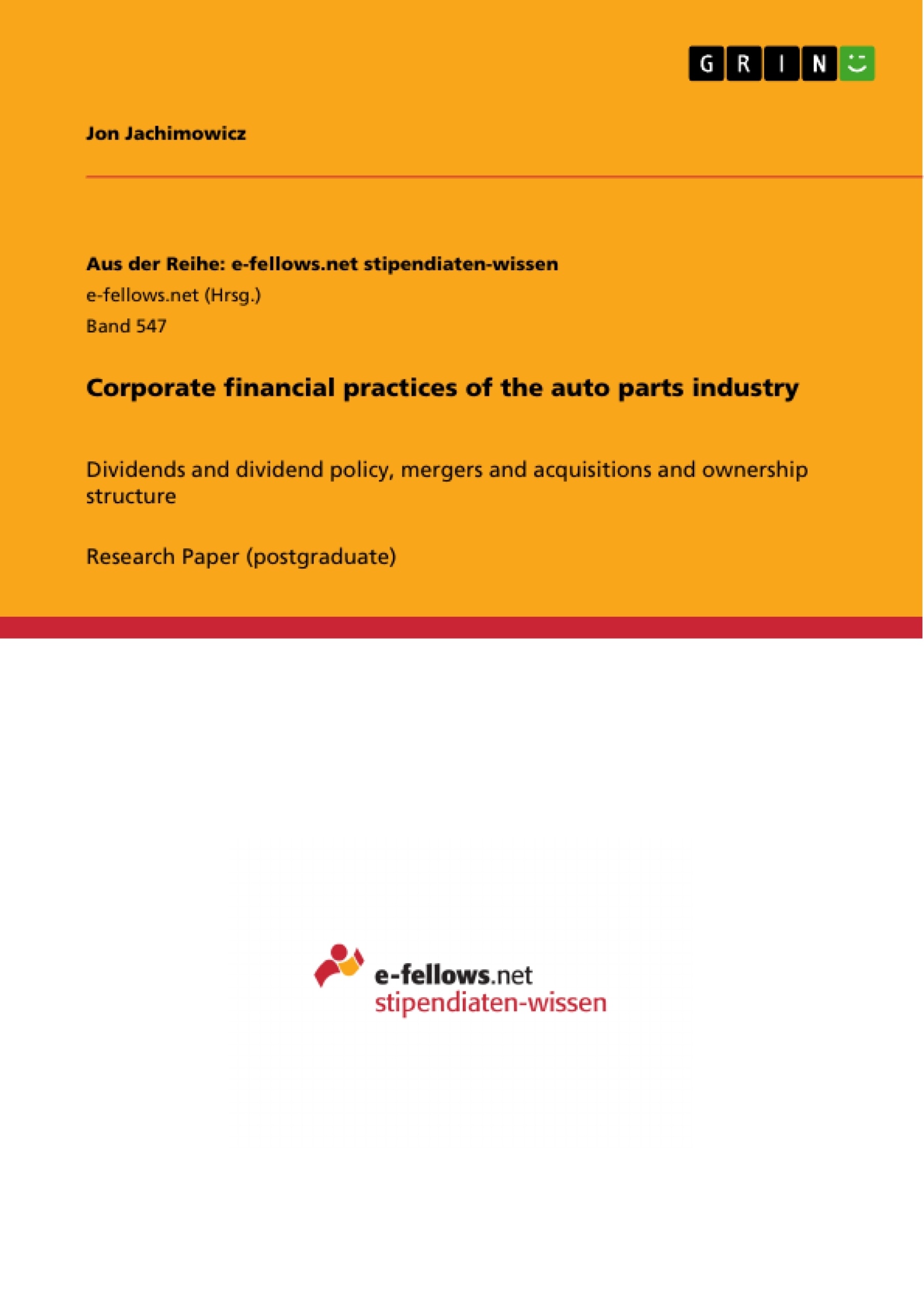This report aims to evaluate the validity of corporate financial practices in the under-‐researched auto parts industry, additionally considering the ownership structure of companies because of a division in share distribution. Recent economic struggles have impacted the automobile industry, resulting in stagnating sales on a global scale (Haugh et al, 2010). This affects the auto parts industry, a direct supplier to automobile companies, aftermarket and exchange parts. Rising raw material costs have increased the pressure on auto parts manufacturers, as buyers disallow price increases. Market stimulus, mostly from Asia-‐Pacific, is forecast to increase total parts market by 20% by 2015 (Datamonitor, 2011).
Inhaltsverzeichnis (Table of Contents)
- Executive Summary
- Introduction
- Dividend and Dividend Policy
- Lintner's Model
- Modigliani-Miller Theorem (MM; Miller & Modigliani, 1961)
- Information Asymmetry & Signalling
- The Free Cash Flow Hypothesis
- Conclusion
- Mergers & Acquisitions (M&A)
- Overview of M&A Activity
- A more in-depth look
- Created synergetic value of one example deal
- Ownership Structure
- Ownership distribution
- Ownership distribution and performance
- Ownership identity and performance
- Interrelationships
- Dividend Policy and M&A
- M&A and Ownership Structure
- Dividend Policy and Ownership Structure
- Conclusion
Zielsetzung und Themenschwerpunkte (Objectives and Key Themes)
This report analyzes the corporate financial practices of the auto parts industry, specifically focusing on dividends and dividend policy, mergers and acquisitions, and ownership structure. The report aims to evaluate the validity of these practices within the context of the industry's unique characteristics, such as its fragmentation and competitive nature, and the impact of recent economic challenges.
- Dividend Payout and Dividend Policy
- Mergers and Acquisitions in the Auto Parts Industry
- Ownership Structure and its Influence on Company Performance
- Interrelationships between Corporate Finance Concepts
- Industry Specific Applications and Management Implications
Zusammenfassung der Kapitel (Chapter Summaries)
The report begins with an executive summary outlining the research purpose, design, findings, limitations, and potential applications. The introduction provides an overview of the auto parts industry, including its size, segmentation, and competitive landscape.
The chapter on dividend and dividend policy discusses key theoretical frameworks, including Lintner's model and the Modigliani-Miller theorem. It then explores the role of information asymmetry and signaling in dividend decisions, and examines the free cash flow hypothesis.
The chapter on mergers and acquisitions (M&A) examines the prevalence and nature of M&A activity in the auto parts industry. It explores the potential value creation through M&A and provides a case study to illustrate the creation of synergistic value.
The chapter on ownership structure examines the distribution of ownership and its impact on company performance. It investigates the relationship between ownership identity and performance and explores the potential for performance variations based on different ownership structures.
Finally, the chapter on interrelationships analyzes the potential connections between dividend policy, mergers and acquisitions, and ownership structure, exploring how these concepts might interact within the auto parts industry.
Schlüsselwörter (Keywords)
The primary keywords and focus topics of this report include: auto parts industry, corporate finance, dividends, dividend policy, mergers and acquisitions, ownership structure, industry fragmentation, competition, information asymmetry, signaling, free cash flow hypothesis, value creation, synergistic value, ownership distribution, ownership identity, company performance, interrelationships, and management implications.
- Quote paper
- Jon Jachimowicz (Author), 2012, Corporate financial practices of the auto parts industry, Munich, GRIN Verlag, https://www.grin.com/document/203161



